| Carli Palace of Verona | |
|---|---|
 Facade of the building | |
 | |
| General information | |
| Address | Via Roma 31 |
| Town or city | Verona |
| Country | Italy |
Carli Palace is a Neoclassical style palace located in Via Roma in the city center of Verona.
| Carli Palace of Verona | |
|---|---|
 Facade of the building | |
 | |
| General information | |
| Address | Via Roma 31 |
| Town or city | Verona |
| Country | Italy |
Carli Palace is a Neoclassical style palace located in Via Roma in the city center of Verona.
The building was commissioned by Marquis Giuseppe Della Torre in the second half of the 18th century. At his death in 1778, he left the building to his wife Elena Carli. A few years later, her brother Count Alessandro Carli rebuilt the palace improving its structure and, in 1812, he sold it to the Basilea brothers.
In 1839 the building was purchased by the Imperial Austrian Authorities as the house of Supremo Imperial Regio Senato di Giustizia del Regno Lombardo Veneto (the Supreme Court of Justice for the Kingdom of Lombardy–Venetia). It performed this function until 1851.
In 1853 the building became Field Marshal Johann Joseph Radetzky's residence, the Lombardo-Veneto Civilian and Military Governor.
In 1857 it was converted into an accommodation for high-rank guests, subsequently in 1859 the Archduke Albrecht, Duke of Teschen, Commander in Chief of the Veneto Army, established his Headquarters.
In October 1866, at the end of the Third War of Independence, the act of ceding of Verona to the Local Municipality was signed here, in the "Sala degli Stucchi".
The building maintained its military functions even under the Kingdom of Italy, as the seat of the Corps Headquarters deployed in Verona.
On February 22, 1951, an Italian four star Army headquarters (HQ) was activated in the building, but on July 10 it became a NATO headquarters, named Allied Land Forces Southern Europe (LANDSOUTH), until 1999, when it was reappointed as JOINT COMMAND SOUTH (JC SOUTH). The headquarters were de-activated on July 1, 2004.
Since 1997, Palazzo Carli has been the seat of the Italian Army Operational Land Forces Command (COMFOTER).
The main body perspective on an inner courtyard where there is a beautiful fountain. The facade is divided into three registers, the ground are rusticated arches with Doric pillars, the first floor there is a large central hall with a loggia. Inside they are preserved frescoes of Giambettino Cignaroli, Domenico Pecchio and Marco Marcola.

Veneto or Venetia is one of the 20 regions of Italy. Its population is about five million, ranking fourth in Italy. The region's capital is Venice while the biggest city is Verona.

Mantua is a city and comune in Lombardy, Italy, and capital of the province of the same name.

Verona is a city on the Adige River in Veneto, Italy, with 258,031 inhabitants. It is one of the seven provincial capitals of the region. It is the largest city municipality in the region and the second largest in northeastern Italy. The metropolitan area of Verona covers an area of 1,426 km2 (550.58 sq mi) and has a population of 714,310 inhabitants. It is one of the main tourist destinations in northern Italy because of its artistic heritage and several annual fairs and shows as well as the opera season in the Arena, an ancient Roman amphitheater.

The Grand Canal is a channel in Venice, Italy. It forms one of the major water-traffic corridors in the city.

The Italian Army is the land-based component of the Italian Armed Forces. The army's history dates back to the Italian unification in the 1850s and 1860s. The army fought in colonial engagements in China, Libya, Northern Italy against the Austro-Hungarian Empire during World War I, Abyssinia before World War II and in World War II in Albania, Balkans, North Africa, the Soviet Union, and Italy itself. During the Cold War, the army prepared itself to defend against a Warsaw Pact invasion from the east. Since the end of the Cold War, the army has seen extensive peacekeeping service and combat in Afghanistan and Iraq. Its best-known combat vehicles are the Dardo infantry fighting vehicle, the Centauro tank destroyer and the Ariete tank and among its aircraft the Mangusta attack helicopter, recently deployed in UN missions. The headquarters of the Army General Staff are located in Rome opposite the Quirinal Palace, where the president of Italy resides. The army is an all-volunteer force of active-duty personnel.
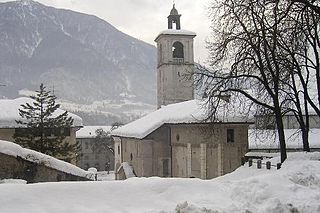
Feltre is a town and comune of the province of Belluno in Veneto, northern Italy. A hill town in the southern reaches of the province, it is located on the Stizzon River, about 4 kilometres from its junction with the Piave, and 20 km (12 mi) southwest from Belluno. The Dolomites loom to the north of the town.

The Kingdom of Lombardy-Venetia, commonly called the "Lombardo-Venetian Kingdom", was a constituent land of the Austrian Empire from 1815 to 1866. It was created in 1815 by resolution of the Congress of Vienna in recognition of the Austrian House of Habsburg-Lorraine's rights to the former Duchy of Milan and the former Republic of Venice after the Napoleonic Kingdom of Italy, proclaimed in 1805, had collapsed.
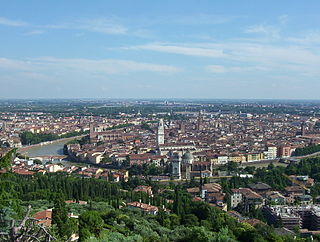
Events in the history of Verona, in Italy.

Malcesine is a comune (municipality) on the eastern shore of Lake Garda in the Province of Verona in the Italian region Veneto, located about 120 kilometres northwest of Venice and about 40 kilometres northwest of Verona.
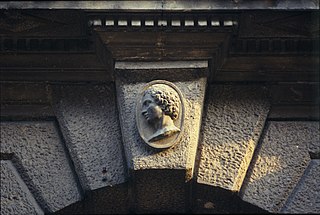
The Giusti Palace and Garden are located in the east of Verona, Italy, a short distance from Piazza Isolo and near the city centre. The palace was built in the sixteenth century. The garden is considered one of the finest examples of an Italian garden.

Palazzo Dalla Torre is a patrician palace in Verona, northern Italy, designed by Italian Renaissance architect Andrea Palladio for Giambattista Dalla Torre. The palazzo was probably built from 1555, but remained unfinished. Allied bombardment in 1945 demolished a great part of the building. However, conspicuous remains of Palladio’s construction survive: the majestic access portal and a courtyard with columns and entablature.

Venetian Renaissance architecture began rather later than in Florence, not really before the 1480s, and throughout the period mostly relied on architects imported from elsewhere in Italy. The city was very rich during the period, and prone to fires, so there was a large amount of building going on most of the time, and at least the facades of Venetian buildings were often particularly luxuriantly ornamented.

The V Army Corps was one of three corps the Italian Army fielded during the Cold War. Based in the regions of Veneto and Friuli-Venezia-Giulia the corps was the army's main combat force. The 5th Army Corps was arrayed close to the Yugoslavian border and tasked with meeting any Warsaw Pact forces that crossed the border. On the left flank of the corps the 4th Alpine Army Corps was tasked with blocking the Alpine passes and in the rear of the corps the 3rd Army Corps served as operational reserve. After the end of the Cold War the corps was reduced in size and on 1 October 1997 it became the 1st Defence Forces Command. In 2013 the COMFOD 1° was disbanded and its function and brigades taken over by the 20th Infantry Division Friuli in Florence.

The Palazzo Michiel Dalle Colonne is a Baroque style palace located on the northern bank of the Grand Canal in the sestiere of Cannaregio in Venice, Italy. It is one building south of the junction of Rio del Santissimi Apostoli with Grand Canal, next to the Palazzo Michiel del Brusà and across the Canal from the Rialto Mercato and the Campo della Pescaria. The palace is also referred to as Palazzo Michiel Dalle Colonne a Santa Sofia.
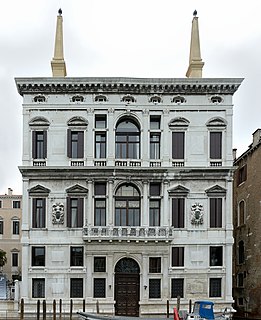
The Palazzo Papadopoli is a Baroque-style palace located on the Canal Grande of Venice, between Palazzo Giustinian Businello and Palazzo Donà a Sant'Aponal in the Sestiere of San Polo, Venice, Italy. The oopsite building is the Palazzo Corner Contarini dei Cavalli.

Operational Land Forces Command - Army Operational Command is the Italian Army's major command tasked with the operational and administrative control of most of its combat forces. COMFOTER - COE reports directly to the Chief of Staff of the Italian Army. The command is based in Rome.
Allied Land Forces Southern Europe (LANDSOUTH) was a military command of NATO's Allied Forces Southern Europe (AFSOUTH) command. Based in Verona in Northern Italy LANDSOUTH was tasked with defending Italy north of the Apennine mountains against a Warsaw Pact or Yugoslavian invasion. Activated in 1951 under an Italian Army four-star general, the command was disbanded in 2004.
The following is a timeline of the history of the city of Verona in the Veneto region of Italy.

Palazzo Giustiniani or the Piccolo Colle is a palace on the Via della Dogana Vecchia and Piazza della Rotonda, in Sant'Eustachio, Rome.
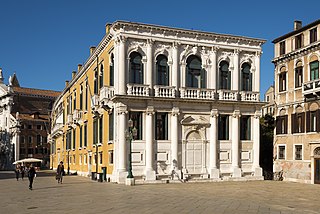
Palazzo Loredan in Campo Santo Stefano is a palace in the San Marco district of Venice, overlooking Campo Santo Stefano. Before the acquisition by the Loredan family in 1536 and the restoration by the architect Antonio Abbondi, it was a group of adjacent buildings, in the Gothic style, belonging to the Mocenigo family. The purchased buildings were substantially restored and made into a single building for the residence of the wealthy noble family of Loredan.